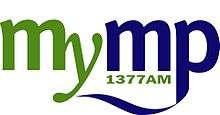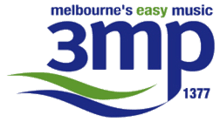Classic Rock Radio
 | |
| Broadcast area | Melbourne RA1[1] |
|---|---|
| Branding | Classic Rock Radio |
| Format | Classic rock |
| Power | 5 kW |
| Callsign meaning |
3 - Victoria Mornington Peninsula |
| Former frequencies | 1380 kHz AM (1976–1978) |
| Owner |
Pacific Star Network (Malbend Pty Ltd) |
| Sister stations |
1116 SEN Aussie Digital KOOOL Digital |
| Website |
www |
Classic Rock Radio is a commercial radio station, broadcast from Rowville, Victoria and licensed to Greater Melbourne. Owned and operated by Pacific Star Network from studios in Richmond, it broadcasts a classic rock format on 1377 AM and DAB+ digital radio.
History
1970s
3MP began transmission 21 July 1976, as Melbourne's seventh commercial radio station and the city's first new commercial station in over 40 years. The original licensees included a consortium of businessmen and media identities.
Unlike other Melbourne radio stations that were based in the inner city areas, 3MP - as the callsign "MP", which stands for Mornington Peninsula, implies - was based in the south eastern suburb of Frankston, originally from studios in Bayside Shopping Centre. The station first broadcast from a transmitter located at Rowville on 1380 kHz AM, changing to 1377 kHz AM in 1978, with its initial music format being a one-for-one mix of solid gold and current Top 40 music. Developed by the station's first General Manager, Ray Bean, and Operations Manager, Geoff Brown, it was strongly targeted at the 25-39 demographic as a less edgy version of the popular "More Music" 10-17 and 18-24 demographic format employed at the time by #1 rated 3XY.
When the station first opened, the transmitter at Rowville was connected to the Frankston studios via a microwave link which had been purchased second-hand from the MMBW (Melbourne and Metropolitan Board of Works). It was surplus equipment recovered from the construction site of the Upper Yarra Dam. The microwave link was licensed to be operated as a 'backup link' should the mandatory PMG (now Telstra) landline fail, but the quality of the microwave link was far superior to the landline and was used as the primary link between the two sites. The two transmitters were (at the time) state-of-the-art RCA AM solid-state stereo transmitters and were connected to a directional antenna array which focused the signal in a south easterly direction roughly covering the Mornington Peninsula.
The transmitter site was located in the middle of a small dairy farm near the corner of Wellington and Stud Roads, Rowville. At the time of construction, the transmitter had no access to 3-phase power due to the lack of power transmission lines. For the first months of operation, the transmitter was powered by two 188kVA diesel generators, one of which was installed as the transmitter's backup power generator and the other which was hired for the duration. During this time, the transmitter needed to be manned on a 24hr basis to ensure the generators were fueled and remained in service, and to ensure that the power supply to the transmitter was efficiently cut-over from one generator to the other in case of generator maintenance or failure. During this time, there was an issue with the directional array, it was functioning abnormally with the main lobe and back lobe shifting in a random fashion. After considerable technical analysis, and having not found any technical reason for the shifting lobes, a rigger was sent up the two masts to re-tighten the bolts of the antenna sections. The transmitter was shut down to allow the rigger to traverse the mast's insulator and climb onto the antenna proper, then the transmitter was turned on and while the rigger was tightening the bolts on the mast sections, the transmitter power and lobe direction were monitored. Suddenly there was a scream from the direction of the mast and, fearing the worst, the transmitter was immediately shut down. Happily, the rigger was uninjured, other than for a slightly burned hand. He had found the section with loose bolts by gripping onto it with his hand, thus forming a circuit and burning his hand. With the transmitter still turned off, the loose bolts were tightened and the transmitter performed as designed thereafter.
Technical design of 3MP's leading edge studios and transmitter was by 3MP's Chief Engineer Murray Korff and was installed by RCA technicians Jim McGrath and John Inneswith. Korff and radio engineer David Wilson divided their time between the studios and the transmitter, working around the clock with the assistance of consultants, Broadcasting Control Board engineers, sub-contractors, telephone technicians and enthusiasts. The leading edge, completely solid-state studio panels and transmitter controls were designed and manufactured by Poul Kirk Electronics Pty Ltd from Perth, Western Australia. Poul Kirk spent several months in 1976 at the studios supervising the installation of the equipment.
The first telephone call made through 3MP's new studio console and its solid-state delay line was made by Brian Bury to Mrs Aleida Wessels, who refused to believe that it was him making the call. She subsequently met him and realised it was a real call.
1980s
Although the original Articles of Association prohibited any one person from owning more than 5% of the shares in Mornington Peninsula Broadcasters Ltd, the station was sold outright to AWA in 1980.
In 1985, rival station 3AK suddenly dumped its beautiful music format, despite strong ratings. The perception of management was that the format did not attract the sort of younger, more impulsive, listeners that had high disposable incomes so therefore were seen to not be attractive to advertisers. 3MP, which at the time was broadcasting a 'hits and memories' format, saw the gap in the market, and within two weeks of 3AK's format change, 3MP had completely revamped its music library, on-air personnel and image to adopt an easy listening format. Following the change, 3MP's previously modest ratings grew strongly, and it became a real competitor with the top FM stations, as well as dominant talkback station 3AW.
In 1987, the station changed hands once again, with 3MP, along with sister stations 2GN Goulburn, 3BO Bendigo, 4CA Cairns, 4TO Townsville and 6KY Perth, purchased by Wesgo Communications for A$40 million.[2][3]
1990s
In 1993, Wesgo Communications purchased rival station 3EE The Breeze, replacing 3EE's format with a simulcast of 3MP. However, following complaints from Triple M, Gold FM, Fox FM and 3AW, the Australian Broadcasting Authority ruled against this,[4] and in 1994 Wesgo launched oldies formatted 'Magic 693', ending the simulcast. Magic 693's format, along with coverage of weekend AFL matches, proved successful as ratings climbed, albeit at the displacement of 3MP.
In 1995, the stations were sold to Southern Cross Broadcasting, which at the time operated 3AW and 3AK, and the newsroom used by both 3EE and 3MP closed. Southern Cross Broadcasting was made to sell two stations, including 3MP. By 1996, it was sold to Goulburn Valley Broadcasters, which operated Shepparton-based 3SR.
2000s
In 2001, ownership of 3MP was transferred to Data and Commerce Limited, which owned and operated Melbourne AM station 3AK. In 2002, 3MP relocated its studios from Frankston to inner suburban Richmond where it shared facilities with 3AK.
The final "on air" line up at 3MP as a music station (before changing to a talk format) was John Tamb - Breakfast (Shawn Cosgrove had previously done the breakfast shift but had left the station a few weeks earlier), Peter O'Callaghan - Mornings, Mark Johnson or Mark Irvine - Afternoon / Drive and Eddie Olek - Evenings.
2010s
In December 2009, existing operator Pacific Star Network and Macquarie Radio Network, the owner of top rating Sydney talkback radio station 2GB, agreed to create the joint-venture 'Melbourne Radio Operations Pty Ltd', to supply radio programming in the Melbourne market. In April 2010, the two signed an interim agreement to launch a new talkback station MTR 1377 - replacing 3MP on 1377 kHz. The station was seen as a reboot of the failed 3AK Talk format, this time mostly Sydney based 2GB programming - to compete against incumbent 3AW. Unfortunately for Macquarie Media and 2GB, the MTR Melbourne station achieved little listener traction, and struggled for both advertising support and listener interest throughout its short life.[5][6]

As MTR launched on 19 April 2010,[7] the 3MP format became exclusive to digital radio, branded as MyMP. For the first year of MyMP's existence, the station ran announcer-free; and, for a period, advertisement-free. Announcers returned to MyMP on 13 May 2011, including Mark Johnson, John Tamb and Eddie Olek.[8] In October 2011, the Australian Communications and Media Authority, acting on a complaint, shut down a pirate radio station operating from the Melbourne suburb of Chadstone, re-broadcasting the MyMP signal on AM radio.[9]

However, the aggressive right-wing nature of MTR's talkback format proved to be a failure, and, with the Pacific Star/Macquarie Radio joint-venture entering administration,[10] on 2 March 2012 MyMP reappeared on 1377 AM, after a short simulcast of sister station SEN.[11] From 7 March, MyMP's announcers returned, with John Tamb on breakfast, Mark Johnson on afternoons and Eddie Olek on drive/evenings.
In April 2012, 3MP was granted a power increase to better cover the northern and western areas of Melbourne - first applied for while operating as MTR.[12] Also in 2012, MyMP introduced 'lifestyle weekends', with Phil Wall hosting My Fishing and Richard Stockman hosting My Wine & Food. Former Sale of the Century host Glenn Ridge moved into weekday mornings, hosting My Melbourne.
In 2015, MyMP adopted the positioner of "Melbourne's greatest hits from the 60s, 70s & 80s", and in May reverted to the 3MP brand, last heard in 2010. In July, the newsroom shared between 3MP and sister station 1116 SEN was closed, replaced with a service from Macquarie National News.[13][14]
On 24 October 2016, 3MP live programming was totally abandoned and the station relaunched as "Classic Rock Radio", essentially a radio station in a box.
Former presenters
- Shawn Cosgrove (Sky Sports Radio)[15]
- Geoff Cox[15]
- Greg Evans (95 3SR FM)[15]
- Jane Holmes (Magic 1278)[15]
- Peter Tarnawski (93.6 Ram FM)[15]
References
- ↑ http://www.acma.gov.au/licplan/defmaps/documents/maps/la_531.pdf
- ↑ "AWA Radio Execs reunite". Radioinfo. 4 June 2004. Retrieved 23 May 2015.
- ↑ "AWA’s 100th Birthday". Radioinfo. 31 July 2013. Retrieved 23 May 2015.
- ↑ Taylor, Thomas (26 November 1993). "Simulcast must stop, 3MP told". The Age. Fairfax Media. Retrieved 17 January 2016.
- ↑ "Macquarie Radio and Pacific Star sign Interim Agreement". ASX ComNews. 16 April 2010. Retrieved 10 May 2015.
- ↑ Quinn, Karl (19 April 2010). "Look who's talking - MTR hits the airwaves". Age. Fairfax. Archived from the original on 22 April 2010. Retrieved 26 April 2010.
- ↑ Day, Mark (19 April 2010). "Talk radio entrant faces a hard, oft-travelled road". The Australian. Features: 31. Retrieved 26 Apr 2010.
- ↑ "MyMP, 3MP's new digital radio station". WebDevSys. Retrieved 2012-12-16.
- ↑ "ACMA search, seizure and enforcement". Amateur Radio Victoria. 8 October 2011. Retrieved 23 May 2015.
- ↑ Bodey, Michael (2012-03-03). "MTR closes, with loss of $15m". The Australian (1 - All-round Country ed.). p. 27. Retrieved 5 March 2012.
- ↑ "3MTR goes dark". Radioinfo. 2 March 2012. Retrieved 10 May 2015.
- ↑ "Reborn 3MP gets a power increase to better cover Melbourne". Radioinfo. 4 April 2012. Retrieved 16 December 2012.
- ↑ Gunn, Nikole (8 July 2015). "Another one bites the dust". Radio Today. Retrieved 9 July 2015.
- ↑ Rawsthorne, Sally (8 July 2015). ""Melbourne’s Home of Sport" shutters its newsroom". MediaWeek. Retrieved 9 July 2015.
- 1 2 3 4 5 "What's On".